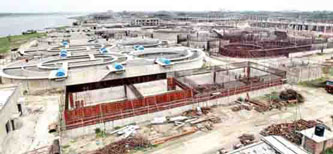
Relocation of tanneries, factories must but not at the cost of leather sector
Md. Joynal Abdin | Monday, 18 April 2016

Leather and leather goods is one of the most potential sectors of Bangladesh economy. It employs about 1,80,000 people directly. This sector includes about 3,500 micro, small and medium leather goods factories with about 110 large industries. The sector is divided into two major heads i.e. leather processing units called tanneries and manufacturer of leather goods like shoe, bag, belt, etc. called leather goods factories. There are about 220 to 250 tanneries in Bangladesh, mostly located at Hazaribagh area of Dhaka city. As a Muslim majority country, Bangladesh used to produce a huge quantity of leathers every year mainly during the Eid-ul-Azha.
Only 15-18 per cent of the total leather production of Bangladesh can meet local demand for leather goods. The rest is export- oriented. Bangladesh's major export earnings come from apparel industry--readymade garment and knitwear export. Until now, RMG is mainly a back-to-back based industry. Bangladesh used to import cloths and accessories as per the buyer's specification and cut the cloths and sew as per its requirement to export RMG products. Low-cost labour is the main strength of Bangladeshi businessmen in RMG sector. We have limited scope for value addition here. Day-by-day, buyers are bargaining for low cost for this cut-and-sewing charge. Therefore, profit of this sector is going down with the passage of time. On the other hand, leather and leather goods is the fourth largest export-earning sector of Bangladesh. Export earnings of this sector are rising with about 48 per cent growth per year. Bangladesh earned US$ 1.29 billion by exporting leather goods in 2013-14 fiscal year. SD Asia forecast that, very soon this export could be increased to US$ 15 billion.
Leather goods sector has the potential to grow up to RMG (ready-made garments) and even more with maximum value addition by using local raw materials if government support is provided to them. Currently, the leather sector is going through a tough time, especially in a conflicting situation to shift tanneries and leather factories from Hazaribagh to the Savar Leather Industrial Park. The government does not want to allow them to stay at Hazaribagh for a single day more. But entrepreneurs are taking abnormally long time to relocate their tanneries there. The government's stand is logical because tanneries are polluting environment in Hazaribagh since their inception. The environment of adjoining areas of Hazaribagh is posing a major threat for healthy living of the people. On the other hand, the government arranged a proper location to shift the tanneries so that the environmental threat could be treated and a congenial atmosphere maintained. From the entrepreneurs' point of view, it is not a matter of one or two days for relocation of the tanneries and start production again. It's a matter of time, cost of relocation, threat of losing buyers if delay is not accepted to deliver orders, prospect of retaining skilled workers without payment for three to five months (required to restart production in the new premises), paying labour without production, so on and so forth.
Pollution has to be stopped. But the government has to remember one thing that leather goods sector is employing about 2,00,000 people and has potential for employing two million in the near future. It is helping us to fight poverty, to generate employment to increase GDP (gross domestic product) growth and to earn foreign currency. So, while pressure must be built up on leather goods entrepreneurs to relocate their tanneries and factories, this must not be done at the cost of the leather sector. We must remember 90 per cent of Bangladeshi raw leather processing plants are located at Hazaribagh. If we just close down everything of that area by force, problem may not be solved. It could further result in a newer problem. It will not be worthwhile to close down the factories for an indefinite period or until relocation. . In such a crisis situation, leather might be smuggled to neighbouring countries. Therefore, pressure could be there but force is not the real solution.
There is enormous potential of Bangladesh's leather goods industry. The sector has already been experiencing about 15 per cent growth since 1990. The global export market of leather goods is estimated at about US$ 230 billion. Bangladesh has captured only 0.56 per cent of the global market. We can easily enlarge this size into at least 3 per cent because Bangladesh produces about 2-3 per cent of global leather output. Bangladesh is exporting leather goods to mainly European markets like Germany, Italy, France, Belgium, Sweden, the UK, Austria and Switzerland etc. Besides these, Bangladesh exports leather goods to the USA, Canada, Japan, China, South Korea, Malaysia and Singapore.
The main problem of Bangladeshi leather goods industry is lower production capacity. Our factories are still unable to produce bulk quantity of same quality products within a shortest lead time. Our production capacity has to be increased to attract large buyers. Both the government and entrepreneurs have to be proactive for capacity building of existing labour of this industry and create new skilled manpower to expand the industry in near future. Technological upgradation is required to produce quality leather products on a large scale. But such upgradation will require additional fund. The government or the development partners could come forward to facilitate such technology fund. Finally, we have to invest more capital in R&D for product diversification.
The writer is Deputy Manager, the SME Foundation, Bangladesh.
[email protected]